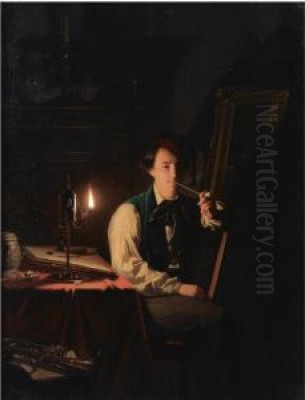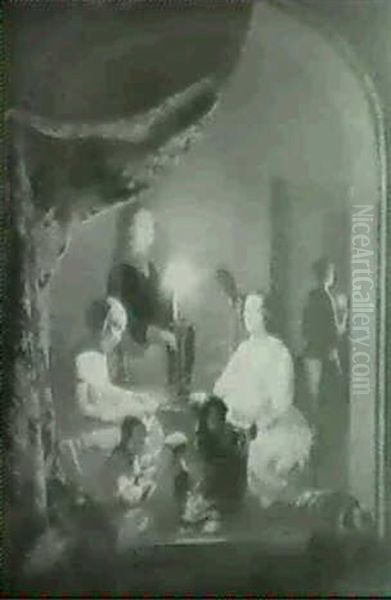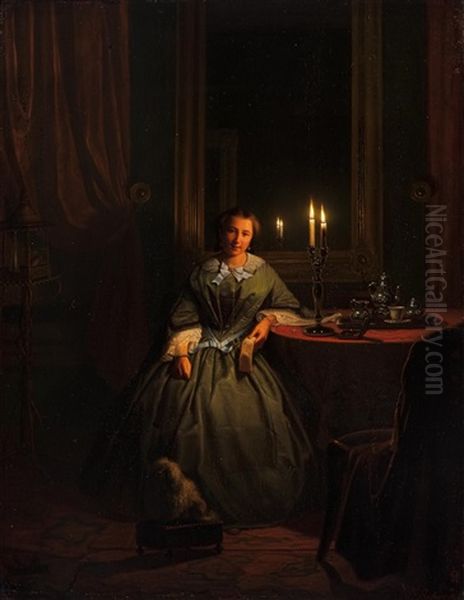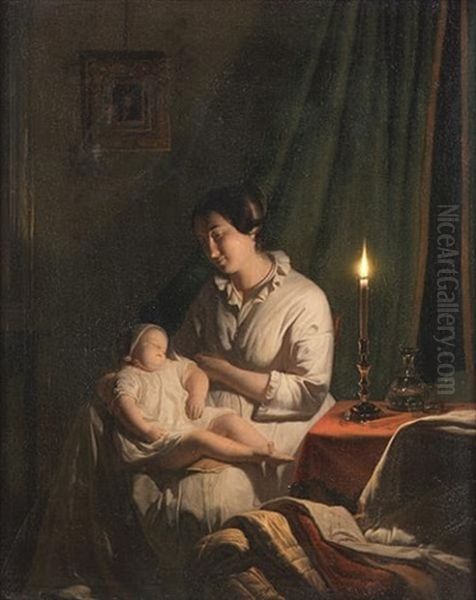
Johannes Rosierse stands as a notable figure in nineteenth-century Dutch art, celebrated for his evocative depictions of everyday life, particularly his mastery of scenes illuminated by candlelight. Born in 1818 and passing away in 1901, his career spanned a significant portion of a century marked by artistic evolution. While details of his personal life remain somewhat obscure, his artistic output provides a clear window into his skills and thematic preoccupations. He specialized in genre painting, carrying forward a long and distinguished tradition within Dutch art, yet carving out his own niche through a focus on nocturnal and artificially lit environments.
Biographical Outline and Artistic Formation
The precise details surrounding Johannes Rosierse's place of birth and death are not clearly documented in readily available historical records. This lack of specific biographical information is not uncommon for artists of the period who may not have achieved the same level of widespread fame as some contemporaries, but it leaves gaps in our understanding of his personal journey. We know he was active as a Dutch painter throughout the latter half of the nineteenth century, establishing a reputation primarily for his figure paintings and genre scenes.
A crucial element in his artistic development was his tutelage under Petrus van Schendel (1806-1870). Van Schendel himself was renowned for his technical brilliance in rendering light effects, especially candlelight and moonlight, often applied to market scenes and interiors. It is highly likely that Rosierse absorbed much of this expertise from his master. Van Schendel's influence is palpable in Rosierse's own predilection for similar subjects and his meticulous attention to the interplay of light and shadow, which became a hallmark of his style. This training provided Rosierse with a strong technical foundation upon which to build his career.
The Art of the Nocturne: Candlelit Scenes

Johannes Rosierse is perhaps best known for his "nocturnes" – scenes set at night or in dimly lit interiors, where the primary light source is often a single candle or lamp. This focus aligns him with a specific sub-genre that gained popularity, tapping into a Romantic fascination with atmosphere and intimacy, while also showcasing considerable technical skill. Painting convincing candlelight requires a sophisticated understanding of how light behaves – its warm glow, the way it falls off into deep shadow, and how it reflects off different surfaces and textures.
His works often depict quiet domestic moments or bustling night markets. In these paintings, the candlelight is not merely illumination; it is central to the mood and composition. It creates pockets of warmth and focus within the surrounding darkness, drawing the viewer's eye to the central figures and activities. This technique imbues his scenes with a sense of intimacy, quietude, or sometimes, the hushed energy of nocturnal commerce. The careful rendering of faces and objects emerging from the shadows demonstrates his debt to his teacher, Van Schendel, and places him within a lineage of artists fascinated by artificial light.
Signature Themes: Markets and Domestic Interiors
Market scenes were a recurring theme in Rosierse's oeuvre. He excelled at capturing the atmosphere of evening or nighttime markets, often illuminated by lanterns or candles. These works allowed him to combine his skill in rendering light with the depiction of lively social interaction and the textures of various goods on display. One notable example is A Fish Market, which was exhibited in London in 1857. Such scenes provided a rich tapestry of human activity and material detail for him to explore.
Another significant work, simply titled Market Scene, gained considerable prestige when it was purchased by Queen Victoria of the United Kingdom as a gift for her husband, Prince Albert. This royal acquisition underscores the appeal and perceived quality of Rosierse's work during his lifetime, suggesting he achieved a degree of international recognition. These market paintings connect to a long tradition in Dutch and Flemish art, harking back to painters like Pieter Aertsen and Joachim Beuckelaer in the 16th century, though Rosierse's focus on artificial light gives his interpretations a distinct nineteenth-century character.

Alongside market scenes, Rosierse frequently painted domestic interiors, often also by candlelight. Works like Family in a Candlelit Interior (measuring 69.5 x 58 cm) and the Dark Scene of Three Girls Preparing Food in a Kitchen (auctioned in April 2024) exemplify this aspect of his work. These paintings typically convey a sense of warmth, tranquility, and familial connection. The focused light source enhances the feeling of enclosure and intimacy, inviting the viewer into a private world. Another example, Young Woman by Candlelight (31 x 23.2 cm), highlights his ability to capture individual figures in quiet contemplation, bathed in the soft glow.
Artistic Style and Technique
Rosierse's style is characterized by careful realism and meticulous attention to detail, particularly in the rendering of textures, fabrics, and facial expressions. His brushwork is generally smooth and controlled, allowing for a high degree of finish. However, his most distinguishing feature remains his handling of light and shadow (chiaroscuro). Unlike the dramatic, high-contrast chiaroscuro of Baroque masters like Caravaggio or Rembrandt van Rijn, Rosierse's use of light is often softer and more atmospheric, suited to the gentle illumination of candles or oil lamps.
His palette tends towards warm tones – browns, reds, oranges, and yellows – especially in the illuminated areas, contrasting with the deep, cool shadows of the surrounding space. This careful colour modulation contributes significantly to the convincing portrayal of artificial light and the overall mood of his paintings. His work continues the legacy of Dutch Golden Age painters like Gerard Dou or Gabriel Metsu, who were masters of depicting interior scenes with refined detail and subtle light effects, adapting these traditions to nineteenth-century sensibilities. The influence of his teacher, Petrus van Schendel, is undeniable in the technical execution of these light effects.
Contemporaries and Artistic Context
Johannes Rosierse worked during a vibrant period in Dutch art history. While he focused on genre scenes, the latter half of the nineteenth century saw the rise of the Hague School, whose members often favoured landscapes and peasant life depicted with a more tonal, atmospheric, and sometimes looser brushwork. Artists like Jozef Israëls, Hendrik Willem Mesdag, Anton Mauve, and the Maris brothers (Jacob and Willem) dominated the Dutch art scene with their often melancholic and realistic portrayals of Dutch life and landscape.

Rosierse's detailed, often anecdotal, candlelit scenes present a contrast to the Hague School's prevailing plein-air aesthetic and broader brushstrokes. His work seems more aligned with earlier nineteenth-century Romantic or Biedermeier sensibilities, or perhaps with contemporary genre painters in other countries who maintained a high degree of finish and narrative clarity. Another Dutch contemporary known for light effects, particularly moonlight and candlelight, was Petrus Kiers (1807-1875). While listed as active during a similar period, specific records detailing direct collaboration or close association between Rosierse and Kiers, or indeed with the major figures of the Hague School like George Hendrik Breitner, are not readily available. His style remained somewhat distinct from the dominant trends of late nineteenth-century Dutch realism.
Comparisons can also be drawn to the broader European context. The meticulous rendering and focus on everyday life echo aspects of Realism, championed in France by artists like Gustave Courbet, although Rosierse's work generally lacks the overt social commentary found in some Realist painting. His focus on light effects also invites comparison, albeit across centuries and styles, with artists like the French painter Georges de La Tour, another master of candlelight scenes, demonstrating the enduring artistic fascination with this type of illumination.
Reception, Legacy, and Museum Presence
The purchase of a Market Scene by Queen Victoria indicates that Rosierse achieved a respectable level of success and recognition during his career. His works were exhibited, collected, and appreciated for their technical skill and charming subject matter. Today, his paintings can be found in museum collections, including internationally renowned institutions such as the British Museum in London and the Rijksmuseum in Amsterdam. This presence in major museums confirms his status as a recognized, albeit perhaps secondary, figure in the history of Dutch art.
His legacy lies primarily in his contribution to the tradition of genre painting, specifically his specialization in candlelit scenes. He successfully adapted the techniques learned from Petrus van Schendel to create a body of work characterized by atmospheric intimacy and detailed observation. While perhaps not an innovator on the scale of Johannes Vermeer or Rembrandt in their handling of light, Rosierse skillfully carved out a niche, producing works that continue to appeal through their warmth, technical proficiency, and evocative portrayal of nineteenth-century Dutch life after dark.
The Enigma of the Personal Life
Despite his artistic achievements, Johannes Rosierse the man remains somewhat elusive. The available historical sources, as synthesized from the provided information, offer little insight into his personality, personal relationships, or specific life events beyond his artistic training and output. There are no widely recorded anecdotes, controversies, or detailed accounts of collaborations with other specific artists beyond the established teacher-student relationship with Van Schendel.

References to other individuals named Rosierse, such as a woodworker mentioned in one document, or figures involved in unrelated historical events like Gabrielle Russier or Johannes Valentinus Andreae (associated with Rosicrucianism), are distinct and separate from the painter. This lack of documented personal detail means our understanding of Johannes Rosierse is largely confined to his artistic production. We appreciate him through his canvases – the quiet interiors, the bustling night markets, all brought to life by the flickering glow of candlelight.
Conclusion: A Master of Atmosphere
Johannes Rosierse occupies a specific and noteworthy place in nineteenth-century Dutch art. As a student of Petrus van Schendel, he became a skilled practitioner of genre painting, distinguishing himself through his specialization in nocturnal and candlelit scenes. His works, characterized by meticulous detail, warm palettes, and a masterful handling of light and shadow, capture the intimate atmosphere of domestic life and the subdued energy of nighttime markets.
While not associated with the dominant Hague School movement, Rosierse maintained a connection to the long tradition of Dutch realism and detailed observation, reminiscent of Golden Age masters like Gerard Dou or Pieter de Hooch. His paintings found favour with collectors, including royalty, and are preserved in major museum collections today. Though biographical details remain scarce, his artistic legacy endures through his evocative canvases, which continue to charm viewers with their technical finesse and atmospheric portrayal of everyday life illuminated by the soft glow of candlelight. He remains a testament to the enduring appeal of finely crafted genre scenes within the rich tapestry of Dutch art history.